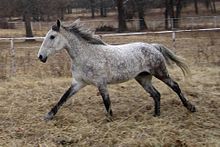American Bashkir Curly
[5]: 452 The American Bashkir Curly has been extensively cross-bred with horses of other breeds, and varies widely in size and conformation; it may be of any color.
The Curly horse was first documented in Eureka, Nevada, in the early 20th century by rancher John Damele and his sons.
Years later, the Dameles managed to catch one, broke it to ride and sold it, thus starting their relationship with the breed.
They called him Copper D. The Dameles did not care much for keeping the breed 'pure', and wanting to improve their horses, added some other blood to their herd.
These two stallions created many offspring for the Dameles, and are in hundreds of Curly horses' pedigrees today.
[4]: 248 Some horses carry curly-coat genes but display little or no curliness; their offspring may be fully curly.
Research indicates a protein is missing from the hair of Curlies which may be what causes allergic reactions to horses in people with allergies, but the study was never officially published.
They are the original standing Curly Registry, and have a closed stud book, only issuing new registrations to horses with two ABCR registered parents.
CSI was created to support Curly owners and breeders in improvement of breeding stock, promotion, and marketing.
Though eye catching and unusual in the show ring, Curlies have the movement, endurance, and heart to excel in competition.
Curlies have been shown at upper levels of dressage and show jumping, and others have proved the reliable mount and patient teacher for the weekend competitor.
Curlies have carried horse-allergic riders from beginner status through ever more advanced stages of equestrianism.
About 10% of the crossbreds will do one of the ambling gaits such as the running walk, fox trot or the stepping pace, which is also called the "Curly shuffle".


